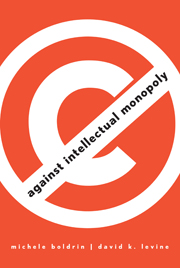Book contents
- Frontmatter
- Contents
- Acknowledgments
- 1 Introduction
- 2 Creation under Competition
- 3 Innovation under Competition
- 4 The Evil of Intellectual Monopoly
- 5 The Devil in Disney
- 6 How Competition Works
- 7 Defenses of Intellectual Monopoly
- 8 Does Intellectual Monopoly Increase Innovation?
- 9 The Pharmaceutical Industry
- 10 The Bad, the Good, and the Ugly
- References
- Index
- Plate Section
7 - Defenses of Intellectual Monopoly
Published online by Cambridge University Press: 30 July 2009
- Frontmatter
- Contents
- Acknowledgments
- 1 Introduction
- 2 Creation under Competition
- 3 Innovation under Competition
- 4 The Evil of Intellectual Monopoly
- 5 The Devil in Disney
- 6 How Competition Works
- 7 Defenses of Intellectual Monopoly
- 8 Does Intellectual Monopoly Increase Innovation?
- 9 The Pharmaceutical Industry
- 10 The Bad, the Good, and the Ugly
- References
- Index
- Plate Section
Summary
We focused at the outset on the many successful industries in which competition and innovation have gone and still go hand in hand. Then, we documented the many social evils that the presence of intellectual monopoly, in the form of either patents or copyrights, brings about. In Chapter 6, we introduced a theoretical framework capable of explaining the very same existence of innovative competitive industries, their evolution, and the call for intellectual monopoly arising from those industries once they mature and turn stagnant. Yet we have also learned that the same theoretical framework rationalizing competitive innovations also predicts that innovations of social value may fail to materialize under competition. This leaves open the theoretical possibility that intellectual monopoly increases overall innovation. If intellectual monopoly delivers substantially more innovation than competition, it might be a worthwhile system, despite the many costs we documented in Chapters 4 and 5. Hence, the issue is worthy of further investigation, which we pursue next in two steps. In this chapter, we examine the theoretical reasons – other than the indivisibility already discussed in Chapter 6 – adduced to support the existence of intellectual monopoly. In Chapter 8, we report on the extent to which patents and copyrights increase the social rate of creation and innovation.
We are keenly aware that there are many who argue in favor of intellectual monopoly. They often provide logically correct reasons why, all other things equal, intellectual monopoly would deliver more innovation than competition.
- Type
- Chapter
- Information
- Against Intellectual Monopoly , pp. 149 - 183Publisher: Cambridge University PressPrint publication year: 2008
- 2
- Cited by

